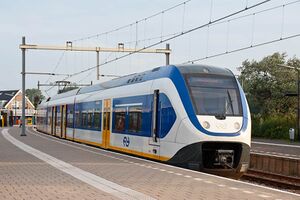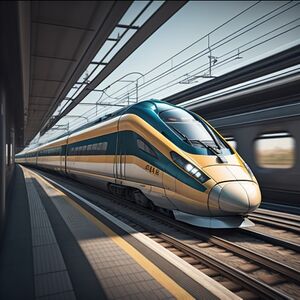FLO Railways
| FLO Railways.png | |
| Type | State-owned enterprise |
|---|---|
| Industry | Rail transport, Logistics, Bus |
| Headquarters | Northcliff, Floria |
| Area served | Apollonia (Serves as Florian part of Apollonian Express. |
| Products | Rail transport, cargo transport, services |
| Owner(s) | Florian Government |
FLO Railways is a Florian state-owned company and is the principal railway operator in Floria. Founded in the 1670's after the government purchase of High Speed Floria. The Florian rail network is one of the largest and busiest in the world. FLO Railways provides both long-distance and regional transport nationwide with high speed capability in the west.
The rail infrastructure and freight services are also maintained and carried out by the company.
History
Purchase of High Speed Floria
Coverage
Types of train service


FLO Railways operates two main types of passenger services: 'Sprinter' and 'Intercity', each designed to cater to different travel needs within Floria.
Sprinter Services
Sprinter services are primarily designed for local travel, providing frequent stops at all stations along their routes. This makes them an essential option for passengers traveling within urban areas or between smaller towns. Sprinter trains are commonly used on regional and suburban routes, where high-frequency service is needed to accommodate the demand. On smaller lines, Sprinter services may be the only form of passenger transport available, as these routes typically have lower demand and fewer major stations. This results in Sprinters being a key service for commuters, students, and other residents who rely on public transportation for short-distance travel.
These trains run more frequently compared to long-distance services, ensuring that passengers have convenient access to transportation throughout the day.
Intercity Services
Intercity services are designed for longer-distance travel between major cities, offering fewer stops at key stations along the route. These services were introduced as a replacement for the former High-Speed Floria trains, which offered faster travel but with more limited stops and fewer connections. Intercity services focus on connecting larger cities and economic hubs, such as Northcliff, Dragonmoor, and Vice City. These routes are typically more direct, allowing passengers to travel between major metropolitan areas more quickly and efficiently. Intercity trains are equipped with modern amenities for long-distance travel, including comfortable seating, Wi-Fi, and dining options. They are designed to offer a high-speed, convenient travel experience for passengers traveling between major cities and regions.
Due to their focus on major stations, Intercity trains typically offer faster journey times compared to the more localised Sprinter services, providing an efficient alternative for business travelers and tourists.
Fares and tickets
The T-card until 1743 AN was the common way of fare payment. Single and return tickets, mostly used by tourists and one-off travellers were available at ticket machines and service counters but a surcharge of $1.50 applies. Long term season tickets were available.
Travellers were required to check-in at the start of the journey and check out at their destination if using the T-Card. T-Card could also be used on buses and trams in cities which operated such services.
From 1743, Florian Congress unanimously agreed a reform of pricing for public transportation. For single tickets, categories of ticket were broken into three groups: Flex, Saver, Super Saver. Flex being full price that can be canceled or changed for free before departure with no restrictions whilst Super Saver, the cheapest fare option, is a fixed train and time with no refunds or changes allowed.
"Floriapass" was also introduced in 1743 to replace the T-Card.